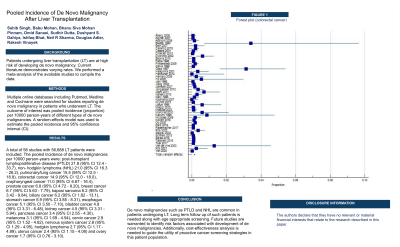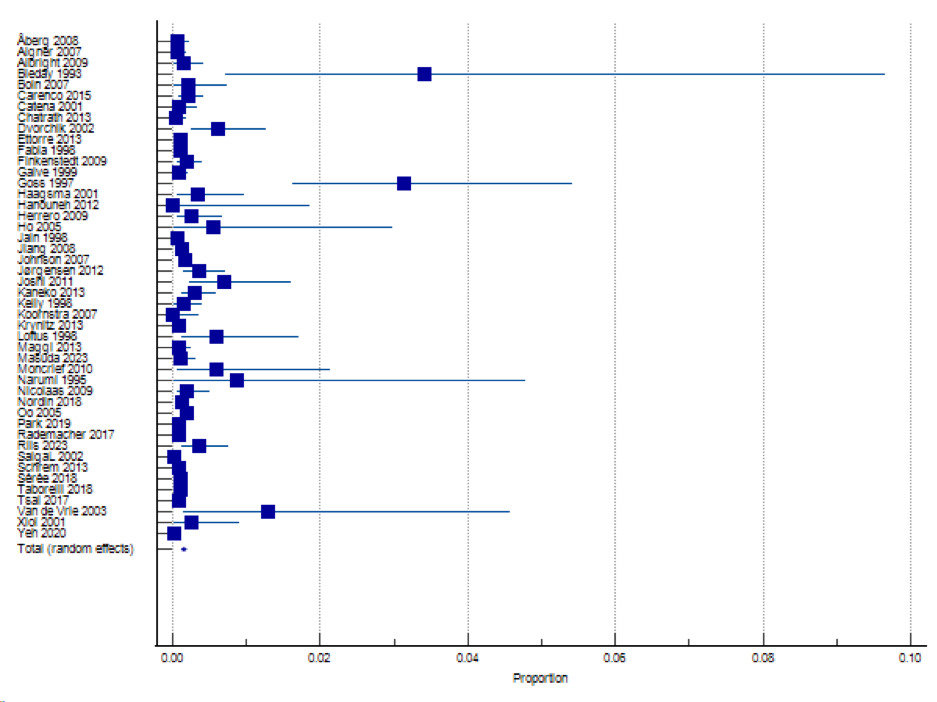Monday Poster Session
Category: Liver
P2965 - Pooled Incidence of de novo Malignancy After Liver Transplantation
Monday, October 28, 2024
10:30 AM - 4:00 PM ET
Location: Exhibit Hall E

Has Audio
.jpg)
Sahib Singh, MD
Sinai Hospital
Baltimore, MD
Presenting Author(s)
Sahib Singh, MD1, Babu Mohan, MD2, Bhanu Siva Mohan Pinnam, MD3, Omid Sanaei, MD4, Sudhir Dutta, MD1, Dushyant S. Dahiya, MD5, Ishfaq Bhat, MD4, Neil R Sharma, MD, FACG6, Douglas Adler, MD7, Rakesh Vinayek, MD1
1Sinai Hospital, Baltimore, MD; 2Orlando Gastroenterology PA, Orlando, FL; 3John H. Stroger, Jr. Hospital of Cook County, Chicago, IL; 4University of Nebraska Medical Center, Omaha, NE; 5The University of Kansas School of Medicine, Kansas City, KS; 6IOSE. Peak Gastroenterology & Gastrocare Partners., Colorado Springs, CO; 7Center for Advanced Therapeutic (CATE), Centura Health, Porter Adventist Hospital, Peak Gastroenterology, Denver, CO
Introduction: Patients undergoing liver transplantation (LT) are at high risk of developing de novo malignancy. Current literature demonstrates varying rates. We performed a meta-analysis of the available studies to compile the data.
Methods: Multiple online databases including Pubmed, Medline and Cochrane were searched for studies reporting de novo malignancy in patients who underwent LT. The outcome of interest was pooled incidence (proportion) per 10000 person-years of different types of de novo malignancies. A random-effects model was used to estimate the pooled incidence and 95% confidence interval (CI).
Results: A total of 56 studies with 56,688 LT patients were included. The pooled incidence of de novo malignancies per 10000 person-years were: post-transplant lymphoproliferative disease (PTLD) 21.8 (95% CI 12.4 - 33.7), non-hodgkin lymphoma (NHL) 21.0 (95% CI 16.3 - 26.2), pulmonary/lung cancer 15.5 (95% CI 12.5 - 18.8), colorectal cancer 14.9 (95% CI 12.0 - 18.0) (Figure 1), oropharyngeal cancer 11.0 (95% CI 6.67 - 16.4), prostate cancer 6.8 (95% CI 4.72 - 9.20), breast cancer 6.7 (95% CI 5.63 - 7.79), kaposi sarcoma 6.2 (95% CI 3.42 - 9.84), biliary cancer 6.2 (95% CI 1.82 - 13.1), stomach cancer 5.9 (95% CI 3.85 - 8.31), esophagus cancer 5.1 (95% CI 3.50 - 7.10), bladder cancer 4.8 (95% CI 3.31 - 6.48), kidney cancer 4.5 (95% CI 3.31 - 5.94), pancreas cancer 3.4 (95% CI 2.55 - 4.30), melanoma 3.1 (95% CI 1.69 - 4.94), cervix cancer 2.9 (95% CI 1.52 - 4.82), nervous system cancer 2.8 (95% CI 1.29 - 4.95), hodgkin lymphoma 2.7 (95% CI 1.17 - 4.89), uterus cancer 2.4 (95% CI 1.15 - 4.08) and ovary cancer 1.7 (95% CI 0.76 - 3.10).
Discussion: De novo malignancies such as PTLD and NHL are common in patients undergoing LT. Long term follow up of such patients is needed along with age appropriate screening. Future studies are warranted to identify risk factors associated with development of de novo malignancies. Additionally, cost-effectiveness analysis is needed to guide the utility of proactive cancer screening strategies in this patient population.

Disclosures:
Sahib Singh, MD1, Babu Mohan, MD2, Bhanu Siva Mohan Pinnam, MD3, Omid Sanaei, MD4, Sudhir Dutta, MD1, Dushyant S. Dahiya, MD5, Ishfaq Bhat, MD4, Neil R Sharma, MD, FACG6, Douglas Adler, MD7, Rakesh Vinayek, MD1. P2965 - Pooled Incidence of <i>de novo</i> Malignancy After Liver Transplantation, ACG 2024 Annual Scientific Meeting Abstracts. Philadelphia, PA: American College of Gastroenterology.
1Sinai Hospital, Baltimore, MD; 2Orlando Gastroenterology PA, Orlando, FL; 3John H. Stroger, Jr. Hospital of Cook County, Chicago, IL; 4University of Nebraska Medical Center, Omaha, NE; 5The University of Kansas School of Medicine, Kansas City, KS; 6IOSE. Peak Gastroenterology & Gastrocare Partners., Colorado Springs, CO; 7Center for Advanced Therapeutic (CATE), Centura Health, Porter Adventist Hospital, Peak Gastroenterology, Denver, CO
Introduction: Patients undergoing liver transplantation (LT) are at high risk of developing de novo malignancy. Current literature demonstrates varying rates. We performed a meta-analysis of the available studies to compile the data.
Methods: Multiple online databases including Pubmed, Medline and Cochrane were searched for studies reporting de novo malignancy in patients who underwent LT. The outcome of interest was pooled incidence (proportion) per 10000 person-years of different types of de novo malignancies. A random-effects model was used to estimate the pooled incidence and 95% confidence interval (CI).
Results: A total of 56 studies with 56,688 LT patients were included. The pooled incidence of de novo malignancies per 10000 person-years were: post-transplant lymphoproliferative disease (PTLD) 21.8 (95% CI 12.4 - 33.7), non-hodgkin lymphoma (NHL) 21.0 (95% CI 16.3 - 26.2), pulmonary/lung cancer 15.5 (95% CI 12.5 - 18.8), colorectal cancer 14.9 (95% CI 12.0 - 18.0) (Figure 1), oropharyngeal cancer 11.0 (95% CI 6.67 - 16.4), prostate cancer 6.8 (95% CI 4.72 - 9.20), breast cancer 6.7 (95% CI 5.63 - 7.79), kaposi sarcoma 6.2 (95% CI 3.42 - 9.84), biliary cancer 6.2 (95% CI 1.82 - 13.1), stomach cancer 5.9 (95% CI 3.85 - 8.31), esophagus cancer 5.1 (95% CI 3.50 - 7.10), bladder cancer 4.8 (95% CI 3.31 - 6.48), kidney cancer 4.5 (95% CI 3.31 - 5.94), pancreas cancer 3.4 (95% CI 2.55 - 4.30), melanoma 3.1 (95% CI 1.69 - 4.94), cervix cancer 2.9 (95% CI 1.52 - 4.82), nervous system cancer 2.8 (95% CI 1.29 - 4.95), hodgkin lymphoma 2.7 (95% CI 1.17 - 4.89), uterus cancer 2.4 (95% CI 1.15 - 4.08) and ovary cancer 1.7 (95% CI 0.76 - 3.10).
Discussion: De novo malignancies such as PTLD and NHL are common in patients undergoing LT. Long term follow up of such patients is needed along with age appropriate screening. Future studies are warranted to identify risk factors associated with development of de novo malignancies. Additionally, cost-effectiveness analysis is needed to guide the utility of proactive cancer screening strategies in this patient population.

Figure: Pooled incidence of colorectal cancer
Disclosures:
Sahib Singh indicated no relevant financial relationships.
Babu Mohan indicated no relevant financial relationships.
Bhanu Siva Mohan Pinnam indicated no relevant financial relationships.
Omid Sanaei indicated no relevant financial relationships.
Sudhir Dutta indicated no relevant financial relationships.
Dushyant Dahiya indicated no relevant financial relationships.
Ishfaq Bhat indicated no relevant financial relationships.
Neil R Sharma: Boston Scientific – Consultant. Medtronic – Consultant. Olympus – Consultant. Steris – Consultant.
Douglas Adler: Boston Scientific and Micro Tech. – Consultant.
Rakesh Vinayek indicated no relevant financial relationships.
Sahib Singh, MD1, Babu Mohan, MD2, Bhanu Siva Mohan Pinnam, MD3, Omid Sanaei, MD4, Sudhir Dutta, MD1, Dushyant S. Dahiya, MD5, Ishfaq Bhat, MD4, Neil R Sharma, MD, FACG6, Douglas Adler, MD7, Rakesh Vinayek, MD1. P2965 - Pooled Incidence of <i>de novo</i> Malignancy After Liver Transplantation, ACG 2024 Annual Scientific Meeting Abstracts. Philadelphia, PA: American College of Gastroenterology.
